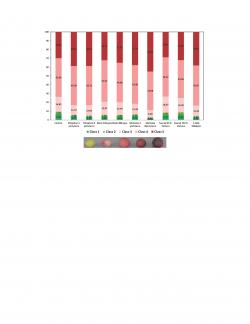Cranberry Physiology/Fruit Quality Research
Selected Highlights of the 2020 Cranberry Physiology/Fruit Quality Program
Dr. Giverson Mupambi with support from Krystal DeMoranville
Research Highlights:
Use of plant growth regulators to improve fruit quality: We continued evaluating new plant growth regulators (PGR) to improve fruit quality. Several PGR formulations and adjuvant combinations were tested for improving red coloration. Fruit were treated with ethylene releasing compounds (Ethephon 2SL [4 & 8 pints/acre] ® and Motivate ® [4 & 8 pints/acre]), jasmonic acid class compound (Blush® [280 & 480 ppm]) and oxylipins (Sunred® [65 & 130 fl. Oz/acre), and s-abscisic acid (Protone® 1000 ppm). Treatments were applied with supplier recommended adjuvants as well as HERBIMAX®, MSO® CONCENTRATE, and VADER®. The combination of ethylene releasing compounds with VADER® improved fruit color in ‘Stevens’ (Figure 1).
Figure 1: Effect of different plant growth regulators on fruit color of ‘Stevens’ assessed machine vision technology.
Use of biostimulants to improve fruit quality: We evaluated two different plant biostimulants to enhance nutrition efficiency, abiotic stress tolerance, and improve the quality of fruit in ‘Stevens’. The results of this study are still being processed.
Use of PGR’s to improve fruit set: Our aim was to enhance fruit set in cranberry through the use of PGR’s. We evaluated a cytokinin forchlorfenuron (Splendor®) and gibberellic acid (Progibb®). Progibb® improved fruit set, however the plants were not able to support the higher number of berries resulting in a smaller fruit size (Figure 2).
Figure 2: Effect of Progibb® on fruit set in ‘Stevens’
Canopy management to improve fruit quality: We continued our investigation into the effect of mowing, pruning, and sanding to improve light penetration into the canopy and improve fruit quality in ‘Mullica Queen’ and ‘Stevens’. Results from Year 1 showed mowing and pruning improved fruit quality through increased fruit color and reduced fruit rot incidence. For Year 2, we focused on the recovery of the canopy, fruit quality, and yield recovery. Results from the study are still outstanding.
Solar research (blueberry): We conducted a preliminary study to look at the changes in microclimatic conditions, soil moisture, leaf gas exchange, vegetative growth, and yield under solar panels. The results of this study are still being processed.
Extension and outreach efforts:
- Industry: January update meeting, Solar research update meeting, Virtual Grower Lunchtime Bogside Workshop, Webinar: The Role of Dendrometers for Irrigation Management in Apple.
- Academia: Oral presentation and poster- Northeastern Plant, Pest, and Soils Conference (NEPPSC), Oral presentation- Northeast PGR Meeting, Oral presentation-American Society for Horticultural Science 2020 Virtual Conference, Oral presentation- Stockbridge School of Agriculture Virtual Seminar.
Other highlights:
- Funding: (PI) Evaluation of New Cultivars ($22,345 NE SARE & $26,500 HATCH); Enhancing Fruit Quality in Cranberry 2020 ($8,800 CH Bio); Blueberry Solar Research ($4,540 NextSun);(Co-PI) Horticultural Research 2020 ($11,000 CCCGA), Impacts of Dual-Use Solar on Crop Productivity and the Agricultural Economy in Massachusetts and Beyond (Solar Energy Technologies Office DOE)
- Admitted to Stockbridge School of Agriculture in the College of Natural Sciences as an adjunct assistant professor.
- Disciplinary Association: Chair-elect for the Ecological Physiology Professional Interest Group of the American Society for Horticultural Science (ASHS) and invited by ASHS Board of Directors to serve on the ASHS Membership Committee for a 3-year term starting August 2020.
- Published three abstracts as first author (meeting presentation).

